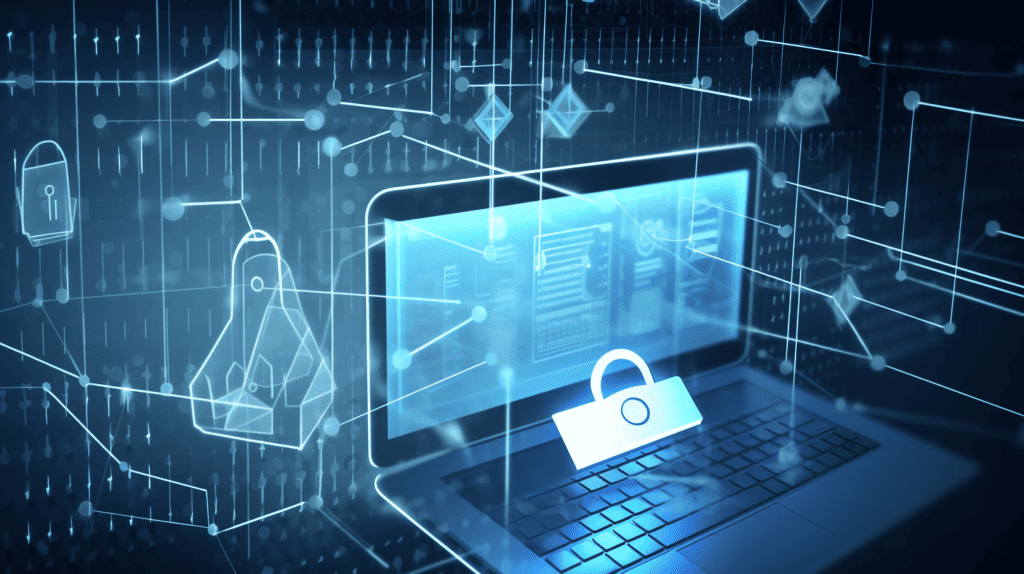Last Updated on June 15, 2023 by Said Al Azri
Introduction
Cybersecurity has risen to prominence in today’s digital economy. To keep your company safe from cybercriminals, you must always be one step ahead of them. In this all-inclusive book, we’ll look at the most pressing cybersecurity issues businesses will face in 2023, analyse real-world cases, and offer concrete advice for mitigating those risks. We will teach you everything you need to know to protect your company’s digital infrastructure, from the ins and outs of phishing and ransomware to the potential dangers posed by emerging technologies. But keep in mind that ensuring cyber safety is not a one-and-done deal. Let’s work together to find our way through the maze of cybersecurity, so you can safeguard your company in 2023 and beyond.

Cybersecurity and Its Significance
The importance of cyber security is growing as the globe becomes more interconnected. Cybersecurity risks are serious for any size company, from sole proprietorships to Fortune 500 conglomerates. It just takes one security breach to cause irreparable harm to a company’s finances, reputation, and viability. Cybersecurity Ventures estimates that annual damages from cybercrime will amount to $6 trillion by 2021. The trend towards greater computerization in company processes suggests that this number will continue to climb.
Furthermore, firms should be concerned about more than just the financial consequences. Loss of client trust due to a cyber assault can be just as harmful to a company’s bottom line. When dealing with a company, customers anticipate that their personal and financial data will be safe. If that trust is broken, the company may lose clients and suffer irreparable reputational harm.
Comprehending the Current Security Climate
To effectively defend against cyber threats, we must first have a firm grasp of the nature of the dangers we face. The most pressing cybersecurity challenges that companies will face in 2023 are discussed here. We’ll break down the inner workings of every type of cyberattack, from ransomware to phishing, and detail the potential damage each can inflict.
Infections via Ransomware
The frequency and sophistication of ransomware assaults are both on the rise. Attackers use malware to lock off a user’s files and then demand payment to unlock them. These attacks are a threat to businesses of all sizes and in all sectors. Sophos found that by 2020, ransomware would have affected 51% of businesses.
The effects of a ransomware assault on a company can be devastating. If vital information is encrypted, business operations may have to be put on hold until it can be decrypted. Furthermore, there is no assurance that the data will be decrypted or that it won’t be compromised in any way, even if the ransom is paid.
Comprehensive Case Analysis:
Take the example of the 2021 ransomware attack on the Colonial Pipeline. The main fuel pipeline in the United States was shut down after a ransomware attack by the criminal organisation DarkSide. In addition to halting petroleum delivery, the incident also forced Colonial Pipeline to pay an estimated $4.4 million in ransom. This incident highlights the necessity of strong cybersecurity measures and the potential severity of ransomware attacks.
Conspiracy Theories Concerning Phishing
Constantly evolving phishing attacks pose a considerable risk of information leakage. By masquerading as a trusted entity, fraudsters steal personal information like passwords and credit card details in a phishing scam.
Cybercriminals’ phishing scams have evolved to include a wider range of deceptive techniques. One tactic is to pose as a trusted sender via email spoofing, while another is to employ social engineering to trick victims into divulging private information.
In-Depth Explanation:
There are numerous phishing scam variations. While whaling targets high-level officials, spear phishing targets specific individuals or businesses. In contrast, smishing is a sort of social engineering that employs text messages to deceive people into divulging private information. A smishing communication may pretend to be from your bank and urge you to verify your account information for safety reasons. Knowing the differences between these phishing attacks can help you avoid being a victim.
Threats on the Rise
Cyberattacks are becoming increasingly sophisticated as technology advances. In 2023, artificial intelligence (AI), internet of things (IoT) gadgets, and other new technologies will pose new risks for enterprises. One potential danger is that AI might be used to automate and improve cyber attacks as it becomes more widely employed. In a similar vein, as more and more gadgets gain internet access, IoT devices become more vulnerable to cyber threats.
Forecasting the Future:
New kind of cyberattacks are likely in the future. For example, quantum computing has the ability to crack common encryption algorithms, creating a serious problem for online safety. Similar to how AI-created deepfakes (fake movies or audio) can be used for complex phishing attempts. Maintaining strong cybersecurity necessitates keeping abreast of these emerging dangers.
Safety for Your Company
Understanding the dangers is only half the battle; taking precautions is essential. Here, you’ll find actionable advice and methods for protecting your company from online dangers.
To begin, it is imperative to set up a solid cybersecurity architecture. In order to manage and reduce cyber risks, a defined set of rules and processes must be in place. Maintaining these policies’ efficacy in the face of changing risks necessitates continuous auditing and updates.
Second, it is crucial to incorporate personnel training into any cybersecurity plan. When it comes to cyber security, untrained staff members can be both the first line of defence and the weakest link. Employees can be better prepared to respond to security incidents by receiving regular training on topics such as identifying phishing emails and securely maintaining sensitive data.
Thirdly, purchasing reliable security equipment is crucial. Antivirus programmes, firewalls, and other preventative security measures are included here. It’s also crucial to update these technologies frequently so they can defend against modern dangers.
Finally, you should have a plan ready to implement in the event of a breach. This should detail what to do in the event of a breach, from discovering and stopping the breach to informing those who may be affected and filing a report with the appropriate authorities.
Extensive Plans:
Threat modelling, security protocol development, and incident response planning are all essential components of a comprehensive cybersecurity policy. Employees should be trained in both general and company-specific cybersecurity best practises, such as how to spot phishing emails and create secure passwords. Antivirus software, firewalls, encryption tools, and other options may all be considered while making an informed decision about your company’s security.
When a Cyber Attack Occurs, What to Do
It is still possible for a cyber attack to occur, even if every precaution is taken. Damage control, discovering the source of the breach, and securing the system against further intrusions become priorities in such situations.
The first step is to stop the leak from spreading further by isolating the compromised network or equipment. After that, you need to do some digging to find out what data was stolen and how it happened. The results of this inquiry should inform efforts to forestall similar assaults in the future. Depending on the situation, this may include revising security procedures, upgrading infrastructure, or retraining staff.
Last but not least, keep customers and stakeholders updated on the incident and your response in an open and honest manner.
Conclusion
Maintaining network security is not a one-and-done job. The challenges facing your organisation and the implementation of effective security measures have been discussed at length throughout this guide. However, it is still possible to suffer a cyber assault while taking all necessary precautions. That’s why it’s crucial to have a plan for bouncing back quickly after an attack while mitigating its effects and preventing more intrusions. Staying informed and vigilant is essential as we continue to navigate the challenging world of cybersecurity. Businesses can safeguard themselves and their customers in the digital age by learning about the risks they face, planning for potential threats, and keeping their security measures up to date. Keep reading as we go deeper into cybersecurity to arm you with the information and resources you’ll need to safeguard your company in 2023 and beyond.
FAQs about Cybersecurity Threats in 2023
Q1: What kinds of cybersecurity risks will be most prevalent in 2023?
A: In 2023, ransomware attacks, phishing schemes, and newly emerging dangers from AI and IoT devices will be the most prevalent sorts of cybersecurity risks. Because of how quickly these threats change, it’s essential for firms to follow the most recent developments in cybersecurity.
Q2: How can I safeguard my company against ransomware attacks?
A: Using a variety of strong security methods, such as constantly patching and updating systems, regularly backing up data, teaching staff members about phishing scams, and utilising dependable security software, will help protect your company from ransomware assaults.
Q3: Are small enterprises vulnerable to online threats?
A: Small firms may not have the same level of security precautions as larger organisations, hence they are frequently targeted by cybercriminals. Strong cybersecurity practises must be implemented by companies of all sizes.
Q4: How can I educate my staff about cybersecurity?
A: Basic cybersecurity procedures including identifying phishing emails, choosing secure passwords, and adhering to company-specific security rules should be covered in employee training. Your team can benefit from regular training updates and reminders to keep cybersecurity front of mind.
Q5. What should I do if my business is the victim of a cyberattack?
A quick response is essential in the event of a cyberattack on your business in order to minimise damage. This include identifying and containing the breach, investigating how it occurred, informing the parties affected, and taking preventative measures against additional assaults.
- Rivers and Lakes: Earth’s Circulatory System in a Jar
- Encapsulated Grandeur: Earth’s Landscapes and the Paradox of Isolation
- Encapsulated Earth: Daylight Divides on a Blue Planet
- Illuminated Isolation: The ‘Earth in a Jar’ Series and Our Collective Reflection
- Encapsulated Ecosystems: A Vision of Earth’s Biodiversity in a Jar






